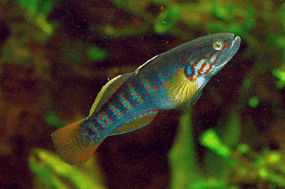Eleotridae
| Eleotridae | |
|---|---|
 | |
| Mogurnda mogurnda | |
| Scientific classification | |
| Kingdom: | Animalia |
| Phylum: | Chordata |
| Class: | Actinopterygii |
| Order: | Perciformes |
| Family: | Eleotridae Bonaparte, 1835 |
Eleotridae is a family of fish commonly known as sleeper gobies found predominantly in the tropical Indo-Pacific, with about 32 genera and 180 species. While many eleotrids pass through a planktonic stage in the sea and some spend their entire lives in the sea; as adults, the majority live in freshwater streams and brackish waters. A few species (Caecieleotris, Milyeringa, Typhleotris, and some Bostrychus) are troglobitic.[1] They are especially important as predators in the freshwater stream ecosystems on oceanic islands such as New Zealand and Hawaii that otherwise lack the predatory fish families typical of nearby continents, such as catfish. Anatomically, they are similar to the gobies (Gobiidae), though unlike the majority of gobies, they do not have a pelvic sucker.[2]
Like the true gobies, they are generally small fish that live on the substrate, often amongst vegetation, in burrows, or in crevices within rocks and coral reefs. Although goby-like in many ways, sleeper gobies lack the pelvic fin sucker and that, together with other morphological differences, is used to distinguish the two families. The Gobiidae and Eleotridae likely share a common ancestor and they are both placed in the suborder Gobioidei, along with a few other small families containing goby-like fishes.[2]
Dormitator and Eleotris, two of the most widespread and typical genera, include a variety of species that inhabit marine, estuarine and freshwater habitats. For example, the fat sleeper goby (Dormitator maculatus) grows to over 2.30 ft (70 cm) and is widely found in fresh to brackish and shallow marine waters of the southeastern United States and Mexico.[3] Some predatory sleeper gobies grow much larger, such as the marbled goby (Oxyeleotris marmorata), a freshwater species from Southeast Asia that can grow to 2 ft (60 cm) long.[4] However, most are much smaller, such as the fresh- and brackish-water species from Australia such as Hypseleotris, known locally as gudgeons (not to be confused with the Eurasian freshwater cyprinid Gobio gobio, also known as the gudgeon and after which the Australian sleeper gobies were likely named).[5]
Genera
The family are divided into two subfamilies: Eleotrinae and Butinae, with these genera:[6]
.jpg)
.jpg)


- Subfamily Butinae
- Bostrychus Lacépède, 1801
- Butis Bleeker, 1856
- Caecieleotris Walsh & Chakrabarty, 2016 [1]
- Incara Visweswara Rao, 1971
- Kribia Herre, 1946
- Odonteleotris Gill, 1863
- Ophiocara Gill, 1863
- Oxyeleotris Bleeker, 1874
- Parviparma Herre, 1927
- Pogoneleotris Bleeker, 1875
- Prionobutis Bleeker, 1874
- Subfamily Eleotrinae
- Allomogurnda Allen, 2003
- Belobranchus Bleeker, 1857
- Bunaka Herre, 1927
- Calumia Smith, 1958
- Dormitator Gill, 1861
- Eleotris Bloch & Schneider, 1801
- Erotelis Poey, 1860
- Giuris Sauvage, 1880
- Gobiomorphus Gill, 1863
- Gobiomorus Lacépède, 1800
- Guavina Bleeker, 1874
- Hemieleotris Meek & Hildebrand, 1916
- Hypseleotris Gill, 1863
- Kimberleyeleotris Hoese & Allen, 1987
- Leptophilypnion Roberts, 2013 [7]
- Leptophilypnus Meek & Hildebrand, 1916
- Microphilypnus Myers, 1927
- Mogurnda Gill, 1863
- Philypnodon Bleeker, 1874
- Ratsirakia Maugé, 1984
- Tateurndina Nichols, 1955
References
- 1 2 Walsh, S.J. & Chakrabarty, P. (2016): A New Genus and Species of Blind Sleeper (Teleostei: Eleotridae) from Oaxaca, Mexico: First Obligate Cave Gobiiform in the Western Hemisphere. Copeia, 104 (2): 506-517.
- 1 2 Helfman, G.S., Collette, B.B. & Facey, D.E. (1997): The Diversity of Fishes. Wiley-Blackwell Publishing. p. 264. ISBN 978-0-86542-256-8
- ↑ Hoedeman, J.J. (1974): Naturalists' guide to fresh-water aquarium fish. Sterling Publishing. p. 1152. ISBN 978-0-8069-3722-9
- ↑ Riehl, R. & Baensch, H.A. (1996): Aquarium Atlas (Volume 1). Voyageur Press. p. 992. ISBN 978-3-88244-050-8
- ↑ Riehl, R. & Baensch, H.A. (1997): Aquarium Atlas (Volume 2). Voyageur Press. p. 1216. ISBN 978-1-890087-06-7
- ↑ Froese, Rainer, and Daniel Pauly, eds. (2016). "Eleotridae" in FishBase. January 2016 version.
- ↑ Roberts, T.R. (2013): Leptophilypnion, a new genus with two new species of tiny central Amazonian gobioid fishes (Teleostei, Eleotridae). aqua, International Journal of Ichthyology, 19 (2): 85-98.